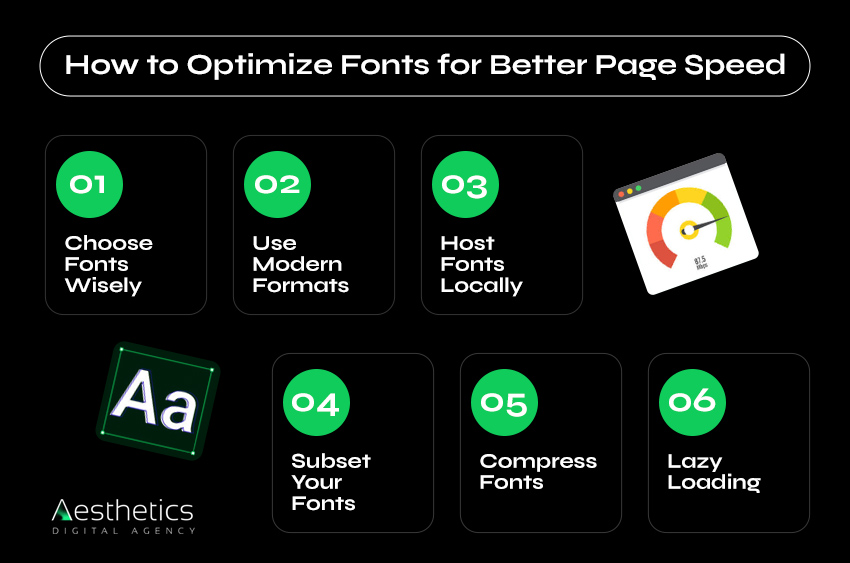When you’re building a website, every decision you make shapes the user experience, from the colors you choose to the fonts you use. However, it’s shocking to learn that fonts, those thin and aesthetic components, can affect a website’s performance. To be precise, they could affect your page loading time which in turn affects user experience, SEO, and conversion.. Let’s break it down in simple terms and figure how fonts affect your website’s page speed
Why Does Page Speed Matter?
Page speed is a key factor in your website’s success. Research on web usability revealed that if a web page requires 3 seconds or more to load, at least 40% of visitors are likely to navigate away. Just like that, all those potential customers poof, are gone! Also, site owners and managers get to know that such search engines as Google pays attention to the speed of the page. Not only do faster sites make visitors happy, but they also keep you relevant in search results.
Now, let’s talk about fonts.
Fonts and Their Impact on Page Speed
While personally, fonts may seem more like aesthetics, they are more important to page speed than one might think. Here’s why:
- It’s all about files
When a site is opened, it is opening files from a server If the file is a font,delivering the font would mean delivering a file. Fonts are one of those files and some of these fonts can be rather large. The same reason why files that are large take more time to load than the small ones.
- Web Fonts vs. System Fonts
Web Fonts such as Google web fonts are hosted files and are loaded from a server every time a visitor is on your page. This can also put additional loading time and slow the blog down.
System Fonts are available as standard on many devices so no download is needed for this type of Font. These load faster and they come with limitations on design.
- Font Formats
There are different formats of fonts, these include .TTF, .OTF, .WOFF, .WOFF2. There are contemporary formats like WOFF2, which are more compatible with the World Wide Web as they have a comparatively small amount of bytes to be downloaded, so they are loaded faster than formats that were used earlier.
- Multiple Font Styles and Weights Every variation of a font (e.g., bold, italic, light) is a separate file. If you’re using a font with multiple styles, your website has to load all those files, increasing the load time.
- Render Blocking When a browser encounters a web font, it might pause rendering the page until the font is fully downloaded. This can result in a blank or partially loaded page, frustrating users.
How to Optimize Fonts for Better Page Speed

Don’t worry; you don’t have to sacrifice beautiful typography for a fast website. Here are some practical steps to optimize your fonts:
- Choose Fonts Wisely
As with any web-design technique, the more fonts and styles one uses, the longer it will take a website to load. With each font added, the whole size of the page grows, which is more data that needs to be fetched by users’ browsers.
If you are able to limit the number of font families and styles that are being used, you can greatly decrease the amount of files being called. For instance, it is better to limit yourself to one or two typefaces with different styles (bold, light, and regular). This makes your design look good and also helps to reduce the number of font files that are used on a website.
- Use Modern Formats
Fonts are delivered in favorite formats, and some of them are designed to be used only on the web. WOFF2 (Web Open Font Format 2) is one of the most effective and universal types of fonts. The benefits include better compression rates than previous formats such as TTF (TrueType Fonts) or OTF (OpenType Fonts), so it will take less time for your users to load your site. Substituting WOFF2 for older formats (TTF, EOT) can increase loading speed severalfold, that is especially important for mobile Internet connection.
- Host Fonts Locally
A lot of websites rely on web font delivery services like Google Fonts to source their web fonts. While these services are convenient, they rely on external servers, which introduces several potential issues, such as:
- Increased load time: Commonly, an external server may be slow or have issues, and cause font files to load slower than necessary for your website.
- Dependency on third-party servers: Outsourcing to third parties means the uptime and performance of your website is in their hands.
- Privacy concerns: The problem with loading fonts from an external server usually entails sharing the user data with that server.
With these dependencies, said by downloading and hosting the fonts on your own server, you do not have to deal with them. Local hosting means that fonts are hosted locally together with the rest of your website, which can decrease the loading time, improve the website performance and increase caching and availability control.
- Subset Your Fonts
When you download a font, you get a set of characters, which can include characters of many languages and symbols, although you need only its subset for your site. For instance, a font can have thousands of symbols and characters of languages you don’t even know.
If you subset your fonts, you are actually able to cut down the size of the font file and only bring in the characters that you will be using. This is useful for non-Latin types et cetera such as Chinese, Arabic or other symbols that might not be required on your website.
Subsetting may help to chop off a great number of glyphs, which may help to halve the size of font files, and thus improve page load times. For instance, if you only emboss only the basic Latin characters, the size of the file created can be considerably small provided that you have not included all the complete character set of the alphabet. Some of the font subsetting generators or services are helpful in developing special font files that contain only those characters which are required.
- Compress Fonts
The most common methods of reducing font size are the use of online font libraries such as Font Squirrel, Transfonter or using other online font compressing utilities which use advanced algorithms to compress font files. This compression helps in making the font files to have quick to load and equally more clear and sharp to be displayed to the user end.
Reducing the size of fonts is most effective when you load your fonts in your site, or when you are using your own fonts, because it helps reduce the size of the total page. They mean that the usage of smaller font files takes substantially less time to load, thus decreasing the waiting time on the site.
- Lazy Loading
Lazy loading is a technique that is mostly used to ensure that some resources such as fonts are loaded only when they are required. This is especially helpful with fonts which the webpage does not need right from the get go, such as fonts for content that is situated beneath the fold.
Rather than downloading all the fonts as soon as the page is requested, lazy loading permits the loading of only the fonts that actually will be needed when the respective content is scrolled into view. This decreases the amount of objects that need to be loaded at once thus making the perceived loading time of the page much shorter.
For instance, the fonts that are used in the main header or the visible part of the page, could appear first, while fonts that are incorporated into the footers or other parts of the content that one scrolls too later, could be loaded later . Lazy loading can increase real page speed and the perception of page speed for the users, particularly on the pages containing large elements or long vertical areas.
The fine line between Design and Performance
This is what many website owners face, the seemingly never ending tug of war between form and function. Graphics may look gorgeous and new attractive fonts can help you create the first unique page, but this has to be combined with usability. Through better font selection and execution, you can have it all: the site that looks as great as it loads incredibly fast.
Final Thoughts
Fonts are not just a visual aspect of your site; they are an aspect of site functionality as well. If you know how to look at them and how to further improve them, it can lead to an overall improvement on page speed, happy users, and even better SEO rankings. Therefore, next time you are choosing your font, do not only stick to the looks of the font, but also consider the effect on the performance of your site or hire the finest developers at Aesthetics Digital UK . Your users, and search engines, will thank you!


